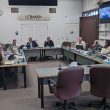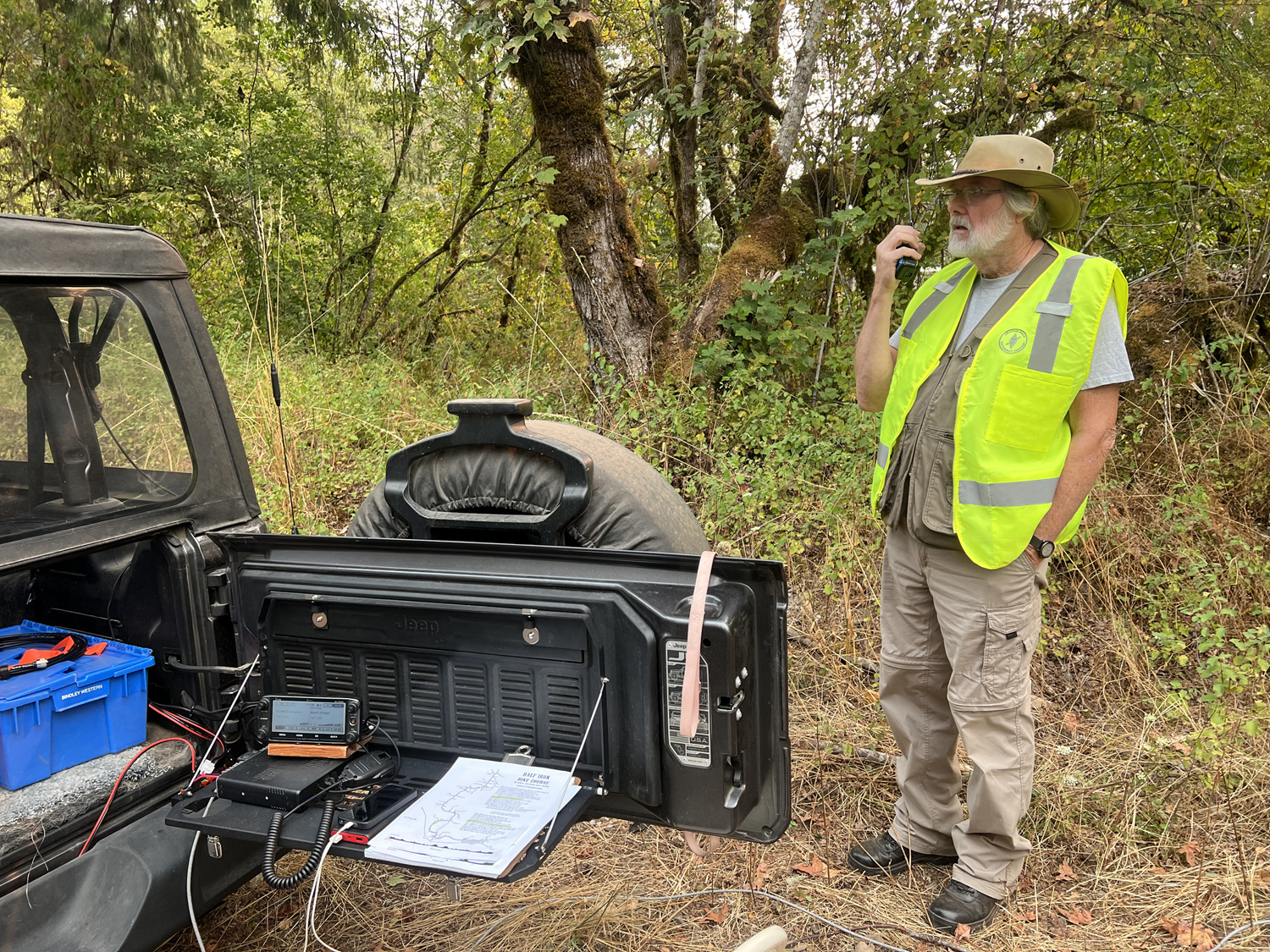By Jennifer Moody
For Lebanon Local
It’s about 10:30 on a Saturday morning. Cyclists blur toward an aid station on Pleasant Valley Road in streaks of fluorescent pink, orange and yellow, hands reaching to snag proffered bottles of water and Gatorade.
“Got those margaritas yet?” one biker calls, waving to the volunteers, who chuckle.
On the gravel roadway shoulder on the east side of the road, Merlin Egan of Lebanon stands next to his Jeep Wrangler and watches. He doesn’t have a margarita – just lunch in a cooler if the Sept. 10 Best in the West Triathlon runs long – but he does have something far more valuable to the passing cyclists.
And right now, he’s using them: the handheld radio attached to his bright green safety vest and the backup radios on the tailgate shelf and on the sun visor of the front window.
One of the cyclists in Saturday’s triathlon has crashed a couple of miles up Pleasant Valley Road. A fellow competitor stopped at the aid station to ask for help, and a volunteer relayed the information to Egan. Egan used his handset to contact Net Control, the operator in charge of radio traffic for the event, and they’ve called for assistance. A race vehicle is on its way to the downed cyclist.
Such is the value of amateur radio in a corner of Linn County that has just one bar of service for cell phones – on a good day. This particular aid station is 11 miles from the start of the 56-mile race and help might have been longer in coming were it not for Egan’s setup.
“I couldn’t fix a bike, and my first aid kit might not be what’s needed,” he says with a shrug. “My job is to get the information back as quickly as I can.”
Egan is a ham radio operator and has been for about a decade. He’s president of the Lebanon Amateur Radio Emergency Services club – LARES, for short – and estimates he’s among some 200 hams in the 97355 area code.
Two hundred is a good number, but not high enough to suit him. It’s fine for events like this – half a dozen amateur radio operators are on duty at today’s triathlon – but it’s not enough for the kind of emergency that could shut down electricity, wipe out cell towers and kill access to the internet.
The mid-valley has been lucky to have avoided most situations like that, but emergency responders believe it’s only a matter of time before there’s a bigger crisis. It could be an ice storm, like the one that took out parts of Salem last year. Or it could be a fire, like the one that left charred ruins in Idanha and Detroit two years ago and the ones chewing through areas of Idaho, Northern California and parts of Oregon even now.
Or it could be the Big One; the earthquake that could strike sometime in the next 50 years, the one with the potential to cause a tsunami that drowns the Oregon Coast and tremors that wreck infrastructure from Portland to Ashland to Bend.
In that kind of an emergency, people won’t be able to pick up their phones – any phones – to call for help.
That’s where Egan and his fellow amateur radio operators will come in. The question, though: Are there enough of them? And will they be able to coordinate with firefighters, police officers, sheriff’s deputies and others who will be inundated with requests for aid?
Egan doesn’t think so. Neither does Wyatt King, a Lebanon resident who co-leads an emergency management committee that’s an initiative of Live Longer Lebanon, a collaborative effort working to advance community health and wellness initiatives.
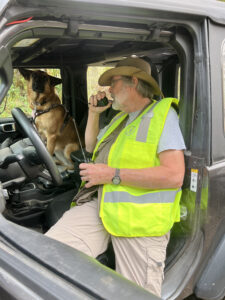
They’d like to see more people trained and licensed to use amateur radio, especially among first responders. They’d like to see regular meetings and regular drills. They’d like for communication to move to the top of government agencies’ emergency planning lists.
“This is something that should be a priority,” King said.
Mid-valley emergency responders don’t disagree. Crisis communication is a priority, they say, and they’re working to improve it – just not by becoming certified as hams themselves, or at least not right now.
“In my 33, 34 years in the fire system, it’s not been common practice to train fire folks on use of amateur radio,” said Joseph Rodondi, chief of the Lebanon Fire District.
That doesn’t mean it never happens, or never could happen, he added. Just in his own experience, firefighters work alongside amateur radio operators rather than joining them. And Lebanon, along with Linn County as whole, is concentrating on other methods of enhancing crisis communication plans at present.
“It doesn’t mean we’re not looking for ways to improve,” Rodondi said. “If you’re not changing, you’re not growing.”
Not all radio is created equal.
Radio operators who are designated “amateur” don’t work commercially or for monetary gain. They use radios to communicate with other operators on frequencies allotted by the Federal Communications Commission for non-commercial use.
The origin of the word “ham” connected with “radio” is a mystery. Most sources think it was likely tacked on as an insult, but it’s a term today that ham radio enthusiasts bear with pride.
Citizens Band, or CB, users also are amateur radio operators. Ham radio differs from CB in a couple of important ways, however. With a range of 1500 watts, ham radios have more power than 4-watt CBs. The range of frequency bands is wider for ham radio, too. Also, while anyone can pick up and use a CB radio, ham radio operators must be licensed.
Both types of radios, and their operators, would be useful for emergency communications. But because ham radios have more power and greater reach – especially when linked to repeaters on high ground – they’re the ones King and Egan are looking to for expanding emergency capabilities.
Private citizens interested in ham radio service need equipment, training and the license, Egan said, but none of that is out of reach.
Age isn’t a barrier – Egan knows at least one 12-year-old ham. Radios cost in the neighborhood of $35 to $50. License training can be done online or with other hams; LARES meets the second Thursday of each month at the Lebanon Center of Linn-Benton Community College on Industrial Way next to the hospital, room 218.
Radio enthusiasts in the mid-valley belong to a soup bowl of acronyms. In addition to the Lebanon group, LARES, there’s a Linn County group called LCARES. There’s also a national association, the Amateur Radio Relay League – known as ARRL – which is the parent group for the other two.
The one to really take note of, however, is the Willamette Valley Amateur Radio Emergency Data Network, which goes by AREDN. It’s important because its whole existence is based around making high quality, high speed data connections.
An AREDN network is capable of transmitting files with a large amount of information, such as photographs and video. It’s designed to be able to work with laptops and cell phones, sending digital data over an analog frequency. Essentially, it’s meant to be a radio version of the internet, although technically, King said, it’s an in-TRA-net, working locally in a closed group rather than publicly worldwide.
AREDN is an advantage over basic ham radio because the latter is strictly voice. AREDN can transfer an email to a cell phone, for instance. It can send medical records from a hospital to a paramedic or map points to a dispatcher.
For AREDN, a “mesh” network works better than a single point-to-point line. That means the more “nodes,” or central setups, the more path possibilities for the digital signal.
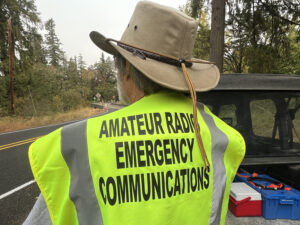
Egan would love to find more people interested in becoming certified as ham radio operators and trained on AREDN so the AREDN mesh can be expanded. Even better, the new operators would be private citizens who happen to live on hilltops.
The challenge with AREDN is it needs line-of-sight links to make connections, and the higher the ground for the station, the better. “We love our trees, but trees get in the way of internet connections,” Egan said.
And while it might be nice to put an antenna on top of, say, the Linn County Courthouse, an awful lot of paperwork and legal agreements would be involved with using a government building.
“That can take years,” Egan said. “So what we’re hoping to do is to have some places unofficially. I have been at this a few years now, and we’re not making a lot of progress because none of us own really high places. So hopefully (with) more of the not-so-high, we can make it work.”
In an ideal world, King said, government would be more involved with AREDN on a personnel level. He’d like to see police, fire and other emergency agencies have regular drills on using the system.
“We want to set up AREDN as a plug-and-play, so they know it’s there and ready, and can push the button when they need to,” he said. “Right now, our big goal is to get the network there so it’s ready and available.”
Drills are important, King added, so nobody has a sharp learning curve when the crisis comes. “It doesn’t matter what kind of cool, fancy equipment you have. If nobody knows how to use it, it’s just a paperweight.”
Local first responders say they are fully supportive of what King and Egan are trying to do. It’s just that right now, they’d prefer to be partners rather than participants.
The Linn County Sheriff’s Office already works alongside local amateur radio groups, particularly on Search and Rescue missions, Sheriff Michelle Duncan said. But deputies already have enough to handle without learning radio operations, too.
“To give them one more task that they would have to routinely train on would not be a good use of our resources,” she said.
The Lebanon Police Department needs six new sworn personnel just to be at full strength for its regular duties, said Lt. Ryan Padua, a communications supervisor. The department just hired one, he said, but another will be leaving soon.
“(Emergency communication training) is definitely important, and I think it’s something that should be a priority, not only for us but for all the other emergency services,” Padua said.
However, he added, “Honestly, the main focus lately has been our recruiting. When we have adequate staffing, we can get back to that.”
Linn County first responders already are working on improving crisis communication in other ways, something many people aren’t aware of or don’t understand, Lebanon Fire Chief Rodondi said.
In 2018, he said, a study was commissioned to look at emergency communication in the fire districts served by the Linn County Sheriff’s Office. The study analyzed all forms of coverage, from cell towers to radios using both handheld and stationary systems, and made recommendations for improving communication for emergency services.
In 2020, Jim Yon, then the Linn County sheriff, suggested to Rep. Jami Cate, R-Lebanon, that COVID relief funding could be used to help replace all fire radio systems in the sheriff’s office dispatch area. Yon said Cate worked with Sen. Fred Girod and Sen. Lee Beyer to obtain $1.2 million to replace all the Linn fire radio systems, part of the recommendation from the 2018 study.
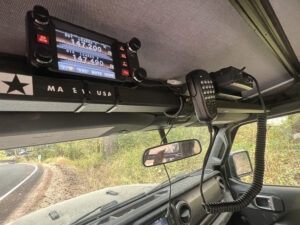
After the 2020 fires that decimated Lyons and Detroit, Linn County also hired a new emergency services manager, Ric Lentz, who has “done a phenomenal job,” Rodondi said.
At the local level, Rodondi said, city officials in Lebanon, Brownsville and Sweet Home and their associated fire districts started having regular conversations after the 2020 fire season to talk about improving disaster response and preparedness. The group hired a consultant who is to begin work this fall and evaluate risk assessment and response. “Communication for sure will be part of that,” Rodondi said.
King stressed he knows local agencies are doing their best. He wants to help make extra duties easier.
“We definitely understand our emergency personnel have big fish to fry. Have huge fish to fry,” he said. “It makes good sense to focus on immediate needs. But at the same time, we don’t want this to die on the vine and not be there when we need it.”
The more radio operators in the area, the better potential coverage, King said – especially because, in a crisis, local hams likely will be dealing with emergencies of their own.
“It’s not very resilient of us to have only a handful of operators with gear and capabilities,” he said.
That’s why he wants first responders to be directly involved. King said he just hopes residents will continue to talk with city leaders, and that those leaders will continue to encourage connections with amateur radio.
“We’re trying to facilitate better collaboration and connection between emergency services in groups that have had some connection with each other. There’s always room for better communication,” he said. “(Amateur radio) can plug a gap in our services that currently isn’t addressed.”
Rodondi said mid-valley communities recognize the need, and the risks, but are still in the early stages of identifying and prioritizing improvements.
“We will get there,” he said. “Communication will be discussed, and there will be opportunities to integrate with our partners in the amateur radio world, so I’m looking forward to that.”


